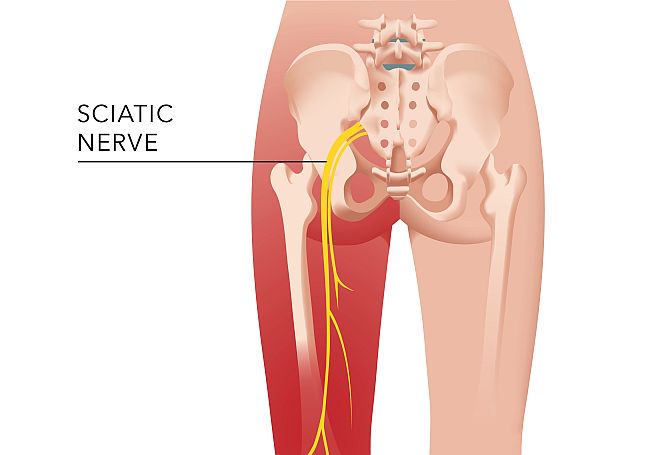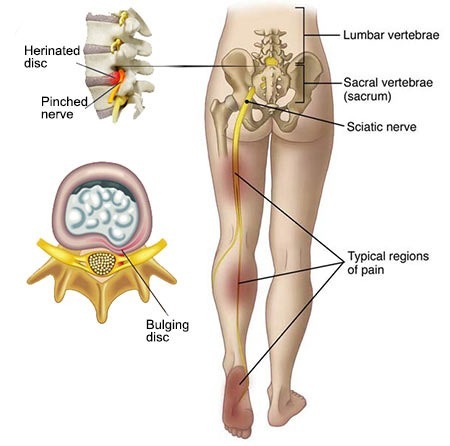
What is Sciatica
Sciatica is a common condition we see regularly in the practice, and it generally responds very well to chiropractic treatment. Many people refer to pain in the back and leg as sciatica, but strictly speaking sciatica is a specific condition that involves irritation of the sciatic nerve. These nerves originate in the lower back and travel down the leg. Since the sciatic nerve runs down the back of the leg to the foot, this is where the pain shows up, especially deep in the buttock and down the back of the thigh. In the lower leg the sciatic nerve divides into two, so depending on where the irritation is, the pain can be at the back and outside of the leg, usually going to the outside of the foot, or it can be on the front of the lower leg, usually going to the top of the foot and the big toe. In the image below you can see the course of the sciatic nerve, where it originates in the lower back, and divides in the back of the knee.

What does sciatica feel like?
Typically when there is nerve irritation you’ll experience nerve pain in the leg, often starting in the buttock and ending in the foot. It can feel like pins and needles, tingling, numbness and loss of sensation. Nerves are what allow us to feel and interpret signals from the body, so if there is nerve compression or irritation, we can experience hypersensitivity or reduced sensitivity in the area where the nerve travels. In the case of sciatica, this is often in the calf, the side of the lower leg and shin, and in the foot, particularly the big toe and the outside of the foot.
What causes Sciatica?
Broadly speaking, there are 3 main causes of sciatica, the most well known is a disc prolapse, also referred to as a ‘slipped disc’, a disc bulge or a herniated disc.
- Disc bulge: between each vertebrae are discs make of tough cartilage on the outside and a gel part in the middle. Due to the accumulative effects of wear and tear, compressive forces in the spine from daily activities like sitting, lifting and injuries, the outer cartilage wall can weaken, eventually resulting in bulging of the disc and tears in the cartilage. If the pressure continues over time, the gel-like fluid in the centre of the disc can protrude out and eventually herniate through the outer cartilage. At this point there is a true disc prolapse and the result is usually direct compression of the disc on the nerve that is exiting the spine at that level. When this happens in the lower back, it produces sciatica.
- Vertebrogenic: Sciatica can also be caused by the vertebrae in the lumbar spine. Conditions such as spinal stenosis (narrowing of the spinal canal), and spondylolisthesis (forward slippage of the vertebrae) can cause compression or traction on the nerves, causing sciatica.
- Myogenic: tight contracted muscles in the buttock can also cause sciatic nerve irritation. The sciatic nerve passes next to a muscle called the piriformis, located in the buttock. This muscle is prone to becoming tight, especially in people who sit a lot. When the piriformis is causing the sciatica, this is called piriformis syndrome.

How do Chiropractors treat sciatica?
The first approach is to determine the cause of the sciatica. Once we’ve assessed your posture, movement, spinal motion and nerve function, we can determine the cause, where/if the nerve is compressed, and the best treatment approach. You can read about our approach to sciatica here.
The goal of treatment is to determine where there is restriction in the vertebral movement, and where there is muscle tension and tightness. By restoring the normal movement in the spine and freeing up motion restriction, the nerve irritation and compression can be progressively reduced, allowing the nerve pain (sciatica) to ease and eventually heal. We also use special wedge-shaped blocks that the patient lies on in order to reduce torsion in the pelvis and help realign it (SOT technique- see https://innatehealthchiro.co.uk/2021/07/24/what-is-the-sot-technique/ for more information about SOT).
Management of disc injuries is very important, so we will advise you on certain exercises to relieve pain, things to avoid, and any other strategies, such as stretching or icing, that may be of benefit in your particular case.
